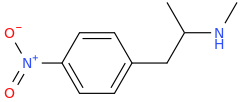Nagelfar
Bluelight Crew
So I had this nutty idea. You can't do a front fused & a back fused tropane; the nitrogen doesn't allow the bonds, but you have things like desoxypipradrol that use two benzenes, and you have the benztropines that are sandwiched closer, why not two cycloalkane rings instead of the two benzenes, and you have the same basic structure of those desoxypipradrol-type stimulants. Since the fused tropane allows for much greater selectivity than the simple cyclohexane, why not use two *different* fused tropanes connecting to a single benzene?
Both fused rings are used from attested examples, none of my strange splicing of bonds to create weirdness, this looks weird enough all on its own:

Cleaned up:

methyl 4-{[(6R)-6-butyl-1-azatricyclo[5.4.0.0³,⁹]undecan-5-yl](phenyl)methylidene}-2-azatricyclo[4.4.1.0²,⁸]undecane-7-carboxylate
Insanity, or ingenious? (cf. these "constrained" PTs)
EDIT:
P.S., came back and re-entered it by name, and it drew it even funkier, hehe:

Anyhow those above three are all the same, here's another one based on a back-bridged & a front bridged (I believe the last one was two back bridged, I can't tell anymore, too turned around with it all):
(2Z)-2-{[(5R)-5-butyl-1-azatricyclo[4.4.0.0²,⁸]decan-4-yl](phenyl)methylidene}-11-methylidene-8-azatricyclo[5.4.0.0⁴,⁸]undecane

"Cleaned-Up":

Re-entered by IUPAC:

Both fused rings are used from attested examples, none of my strange splicing of bonds to create weirdness, this looks weird enough all on its own:

Cleaned up:

methyl 4-{[(6R)-6-butyl-1-azatricyclo[5.4.0.0³,⁹]undecan-5-yl](phenyl)methylidene}-2-azatricyclo[4.4.1.0²,⁸]undecane-7-carboxylate
Insanity, or ingenious? (cf. these "constrained" PTs)
EDIT:
P.S., came back and re-entered it by name, and it drew it even funkier, hehe:

Anyhow those above three are all the same, here's another one based on a back-bridged & a front bridged (I believe the last one was two back bridged, I can't tell anymore, too turned around with it all):
(2Z)-2-{[(5R)-5-butyl-1-azatricyclo[4.4.0.0²,⁸]decan-4-yl](phenyl)methylidene}-11-methylidene-8-azatricyclo[5.4.0.0⁴,⁸]undecane

"Cleaned-Up":

Re-entered by IUPAC:

Last edited:
























